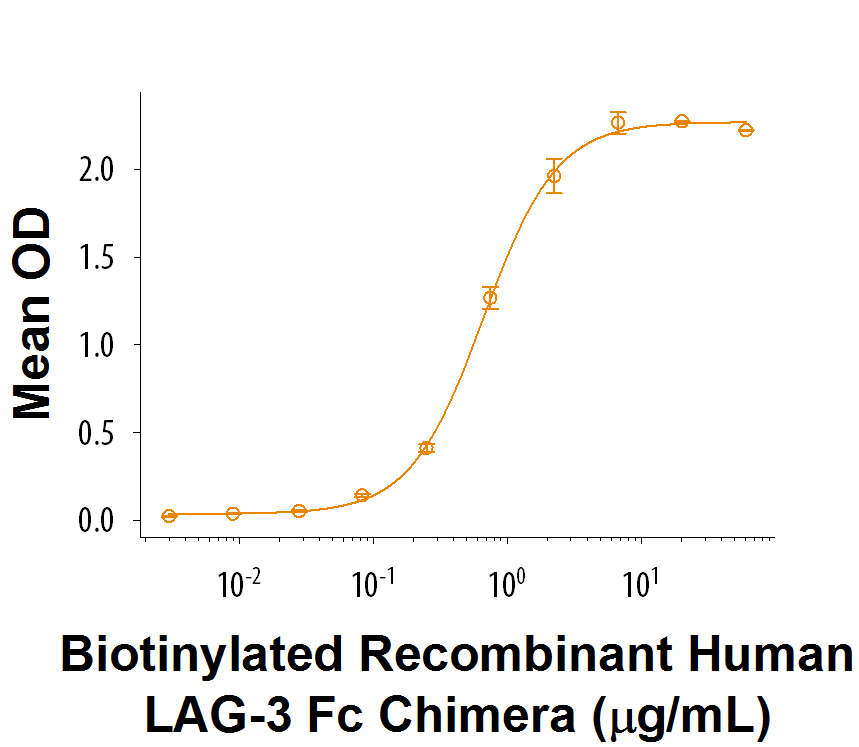Recombinant Human LAG-3 Fc Chimera Biotinylated Protein, CF Summary
Product Specifications
| Human
LAG-3 (Leu23-Leu450) Accession # P18627 |
IEGRMD | Human
IgG1 (Pro100-Lys330) |
| N-terminus | C-terminus | |
Analysis
Product Datasheets
Carrier Free
CF stands for Carrier Free (CF). We typically add Bovine Serum Albumin (BSA) as a carrier protein to our recombinant proteins. Adding a carrier protein enhances protein stability, increases shelf-life, and allows the recombinant protein to be stored at a more dilute concentration. The carrier free version does not contain BSA.
In general, we advise purchasing the recombinant protein with BSA for use in cell or tissue culture, or as an ELISA standard. In contrast, the carrier free protein is recommended for applications, in which the presence of BSA could interfere.
BT2319
| Formulation | Lyophilized from a 0.2 μm filtered solution in PBS with Trehalose. |
| Reconstitution | Reconstitute at 200 μg/mL in PBS. |
| Shipping | The product is shipped at ambient temperature. Upon receipt, store it immediately at the temperature recommended below. |
| Stability & Storage: | Use a manual defrost freezer and avoid repeated freeze-thaw cycles.
|
Scientific Data
 View Larger
View Larger
When Recombinant Human LSECtin/CLEC4G (Catalog # 2947-CL) is coated at 1 µg/mL, 100 µL/well, Biotinylated Recombinant Human LAG-3 Fc Chimera Biotinylated (Catalog # BT2319) binds with an ED50 of 0.2-2 µg/mL.
Reconstitution Calculator
Background: LAG-3
LAG-3 (Lymphocyte activation gene-3), designated CD223, is a 70 kDa type I transmembrane protein that is a member of the immunoglobulin superfamily (IgSF) (1, 2). LAG-3 shares approximately 20% amino acid sequence homology with CD4, but has similar structure and binds to MHC class II with higher affinity, providing negative regulation of T cell receptor signaling (1, 2). Human LAG-3 cDNA encodes 525 amino acids (aa) that include a 28 aa signal sequence, a 422 aa extracellular domain (ECD) with four Ig-like domains, a transmembrane region and a highly charged cytoplasmic region. Within the ECD, human LAG-3 shares 70%, 67%, 76%, and 73% aa sequence identity with mouse, rat, porcine, and bovine LAG-3, respectively. LAG-3 is expressed on activated CD4+ and CD8+ T cells, NK cells, and plasmacytoid dendritic cells (pDC), but not on resting T cells (1-3). LAG-3 on activated CD4+CD25+ Treg cells plays a role in their suppressive activity (4). LAG-3 limits the expansion of activated T cells and pDC in response to selected stimuli (3-5). A soluble 54 kDa form, sLAG-3, can be shed by metalloproteinases ADAM10 and TACE/ADAM17 (6, 7). While monomeric sLAG-3 itself may be inactive, shedding allows for normal T cell activation by removing negative regulation (7). Binding of a homodimerized sLAG-3/Ig fusion protein to MHC class II molecules induces maturation of immature DC, and secretion of cytokines such as IFN-gamma and TNF-alpha by type 1 cytotoxic CD8+ T cells and NK cells (8, 9). sLAG-3/Ig has been used as a potential adjuvant to stimulate a cytotoxic anti-cancer immune response (9, 10). In mice, deletion of LAG-3 and another negative regulator, PD-1, facilitates anti-cancer response but also blocks self-tolerance and increases susceptibility to autoimmune diseases (11, 12). In humans, antibody-mediated down‑regulation of LAG-3 and PD-1 allows more effective control of chronic malaria, while in NOD (non‑obese diabetic) mice, deletion of LAG-3 alone accelerates diabetes (12-14).
- Triebel, F. et al. (1990) J. Exp. Med. 171:1393.
- Baixeras, E. et al. (1992) J. Exp. Med 176:327.
- Workman, C.J. et al. (2004) J. Immunol. 172:5450.
- Huang, C.T. et al. (2004) Immunity 21:503.
- Workman, C.J. et al. (2009) J. Immunol. 182:1885.
- Li, N. et al. (2004) J. Immunol. 173:6806.
- Li, N. et al. (2007) EMBO J. 26:494.
- Andreae, S. et al. (2003) Blood 102:2130.
- Brignone, C. et al. (2007) J. Immunol. 179:4202.
- Brignone, C. et al. (2010) J. Transl. Med. 8:71.
- Woo, S.R. et al. (2011) Cancer Res. 72:917.
- Okazaki, T. et al. (2011) J. Exp. Med. 208:395.
- Bettini, M. et al. (2011) J. Immunol. 187:3493.
- Butler, N.S. et al. (2012) Nat. Immunol. 13:188.
FAQs
No product specific FAQs exist for this product, however you may
View all Proteins and Enzyme FAQsReviews for Recombinant Human LAG-3 Fc Chimera Biotinylated Protein, CF
There are currently no reviews for this product. Be the first to review Recombinant Human LAG-3 Fc Chimera Biotinylated Protein, CF and earn rewards!
Have you used Recombinant Human LAG-3 Fc Chimera Biotinylated Protein, CF?
Submit a review and receive an Amazon gift card.
$25/€18/£15/$25CAN/¥75 Yuan/¥1250 Yen for a review with an image
$10/€7/£6/$10 CAD/¥70 Yuan/¥1110 Yen for a review without an image
